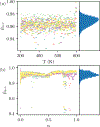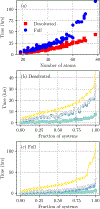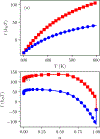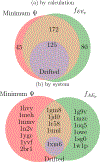Alchemical Grid Dock (AlGDock): Binding Free Energy Calculations between Flexible Ligands and Rigid Receptors
- PMID: 31397498
- PMCID: PMC7263302
- DOI: 10.1002/jcc.26036
Alchemical Grid Dock (AlGDock): Binding Free Energy Calculations between Flexible Ligands and Rigid Receptors
Abstract
Alchemical Grid Dock (AlGDock) is open-source software designed to compute the binding potential of mean force-the binding free energy between a flexible ligand and a rigid receptor-for a small organic ligand and a biological macromolecule. Multiple BPMFs can be used to rigorously compute binding affinities between flexible partners. AlGDock uses replica exchange between thermodynamic states at different temperatures and receptor-ligand interaction strengths. Receptor-ligand interaction energies are represented by interpolating precomputed grids. Thermodynamic states are adaptively initialized and adjusted on-the-fly to maintain adequate replica exchange rates. In demonstrative calculations, when the bound ligand is treated as fully solvated, AlGDock estimates BPMFs with a precision within 4 kT in 65% and within 8 kT for 91% of systems. It correctly identifies the native binding pose in 83% of simulations. Performance is sometimes limited by subtle differences in the important configuration space of sampled and targeted thermodynamic states. © 2019 Wiley Periodicals, Inc.
Keywords: implicit ligand theory; noncovalent binding free energy; protein-ligand; replica exchange; thermodynamic length.
© 2019 Wiley Periodicals, Inc.
Figures












Similar articles
-
Alchemical Grid Dock (AlGDock) calculations in the D3R Grand Challenge 3 : Binding free energies between flexible ligands and rigid receptors.J Comput Aided Mol Des. 2019 Jan;33(1):61-69. doi: 10.1007/s10822-018-0143-9. Epub 2018 Aug 6. J Comput Aided Mol Des. 2019. PMID: 30084078 Free PMC article.
-
Using the fast fourier transform in binding free energy calculations.J Comput Chem. 2018 Apr 30;39(11):621-636. doi: 10.1002/jcc.25139. Epub 2017 Dec 22. J Comput Chem. 2018. PMID: 29270990 Free PMC article.
-
Absolute Alchemical Free Energy Calculations for Ligand Binding: A Beginner's Guide.Methods Mol Biol. 2018;1762:199-232. doi: 10.1007/978-1-4939-7756-7_11. Methods Mol Biol. 2018. PMID: 29594774
-
Advances in Docking.Curr Med Chem. 2019;26(42):7555-7580. doi: 10.2174/0929867325666180904115000. Curr Med Chem. 2019. PMID: 30182836 Review.
-
Free energy calculations of protein-ligand interactions.Curr Opin Chem Biol. 2011 Aug;15(4):547-52. doi: 10.1016/j.cbpa.2011.05.021. Epub 2011 Jun 22. Curr Opin Chem Biol. 2011. PMID: 21684797 Review.
Cited by
-
Learning Efficient, Collective Monte Carlo Moves with Variational Autoencoders.J Chem Theory Comput. 2022 Jun 14;18(6):3622-3636. doi: 10.1021/acs.jctc.2c00110. Epub 2022 May 25. J Chem Theory Comput. 2022. PMID: 35613327 Free PMC article.
-
Implicit ligand theory for relative binding free energies: II. An estimator based on control variates.J Phys Commun. 2020 Nov;4(11):115010. doi: 10.1088/2399-6528/abcbac. Epub 2020 Nov 26. J Phys Commun. 2020. PMID: 33817346 Free PMC article.
-
Recent Developments in Free Energy Calculations for Drug Discovery.Front Mol Biosci. 2021 Aug 11;8:712085. doi: 10.3389/fmolb.2021.712085. eCollection 2021. Front Mol Biosci. 2021. PMID: 34458321 Free PMC article. Review.
-
Sampling Conformational Ensembles of Highly Dynamic Proteins via Generative Deep Learning.Res Sq [Preprint]. 2024 Jun 28:rs.3.rs-4301803. doi: 10.21203/rs.3.rs-4301803/v1. Res Sq. 2024. Update in: J Chem Inf Model. 2025 Mar 10;65(5):2487-2502. doi: 10.1021/acs.jcim.4c01838. PMID: 38978607 Free PMC article. Updated. Preprint.
-
Automated Adaptive Absolute Binding Free Energy Calculations.J Chem Theory Comput. 2024 Sep 10;20(18):7806-28. doi: 10.1021/acs.jctc.4c00806. Online ahead of print. J Chem Theory Comput. 2024. PMID: 39254715 Free PMC article.
References
Publication types
MeSH terms
Substances
Grants and funding
LinkOut - more resources
Full Text Sources

